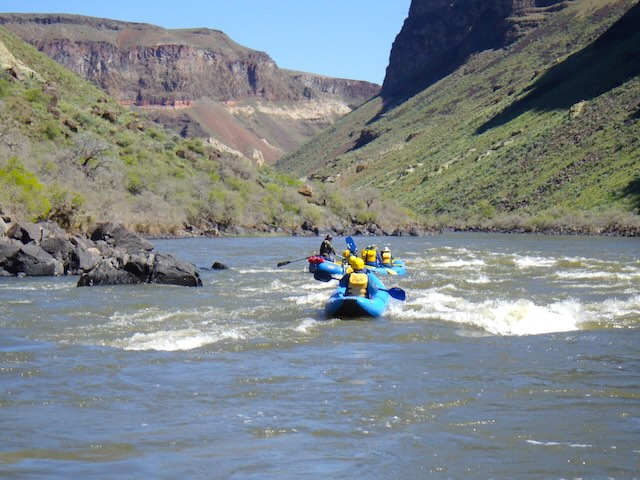My trip through the Owyhee River Canyon went very well, thank you, except for a flat tire on my return home. The transit industry seems to be suffering from a perpetual flat tire, as it carried only 75.6 percent as many riders in March of 2024 as it did in the same month in 2019, according to data posted last week by the Federal Transit Administration. That’s down slightly from 76.0 percent of daily riders in February (adjusting for leap day and correcting for data missing in February’s report). March had the same number of business days in 2024 as in 2019 so no adjustment is necessary there.
The Federal Highway Administration has not yet posted March highway data, but I’ll post an update here as soon as it does.
A handful of major urban areas — Kansas City, Richmond, Oklahoma City, and Tucson — have seen ridership recover to 100 percent of pre-pandemic levels, but this is often because they have eliminated transit fares. From an economic viewpoint, you can’t say there is a significant demand for your service if you have to give it away for large numbers of people to use it.
A few major urban areas have seen ridership recover to 85 to 90 percent of pre-pandemic levels, including Miami, Houston, San Diego, and Tampa-St. Petersburg. Transit was never very significant in these urban areas before the pandemic.
Several other major urban areas are in the 75 to 80 percent range, including New York, Los Angeles, Dallas, Washington, and (surprisingly) Cleveland. However, many others are doing poorly, with ridership below 65 percent of pre-pandemic numbers, including Chicago, Philadelphia, Atlanta, Boston, San Francisco, Minneapolis-St. Paul, St. Louis, and Pittsburgh. Some of these were once major transit havens, so their failure to come closer to recover signals major structural changes in those urban areas: either former transit riders are now working at home or they have moved out of those regions completely.
I’ve been thinking since mid-2020 that post-pandemic transit ridership would plateau at about 75 percent of 2019 numbers, and any growth after that would be due to ordinary population growth. It looks like that is about right.
Running a small rapid on the Owyhee, one of Oregon’s remotest yet most scenic rivers.
As usual, I’ve posted an enhanced version of the Federal Transit Adminitration’s spreadsheet. The FTA’s raw data are in cells A1 through JO2287. Annual totals from 2002 through 2023 are in columns JR through KN. Column KO compares March 2024 with March 2019. Column KP compares 2024 to date with the same months of 2019.
National and mode totals are in rows 2290 through 2309. To show New York’s importance, row 2314 shows the percentage share of ridership that takes place in the New York urban area. Transit agency totals are in rows 2330 through 3319. Urban area totals are in rows 3321 through 3811. These enhancements are on the ridership (UPT for unlinked passenger trips) and service (VRM for vehicle-revenue-miles) worksheets. I hope you find this spreadsheet useful.










I wonder why O’Toole rarely talks about arterials/collector routes.
In our Strong Towns meetups, we believe they are far more devastating and unnecessary than highways.
In what way are arterials and collectors “devastating and unneeded?” How are travelers supposed to get from local roads to freeways and/or to their final destinations?
Traditional streets/boulevards. The way it is done in older planned areas.
Arterials/collectors along with parking mandates are the TOP CONCERNS among Sprawl/modern planning critics.
Have dumbbell roundabout intersections with on-ramps in the center and off-ramps on the edge to redistribute traffic flow.
Look at Carmel, Indiana.
Neighborhoods are now far less divided, and pedestrians can safely cross.
Can you at least agree a few things from the other side?
This was an article about transit. Why should it talk about arterials/connectors? When I’ve discussed highway safety issues I always look at the relative safety of arterials vs. other roads (arterials are the most dangerous).
Why talk about it?
Wow! So, you admit that modern urban planning (areas planned post 1920s) has issues!
Arterials/collectors along with parking mandates are the TOP CONCERNS among Sprawl/modern planning critics. That the heart of the problem.
Instead, you mislead the masses thinking that the main focus of the opposition to jam pack us in dense areas with transit.
You can get plenty of alternative ideas done even IF 80% of housing stock is detached and no transit is provided.
You should perhaps work with Smart Growth, CNU and Strong Towns to stop mandating stroads/arterials/collectors.
Freedom!
https://pbs.twimg.com/media/GNi7i8hWQAAxN9I?format=jpg&name=medium
Yeah freedom. Notice regions depend on transit more tend to be third world
Codes and regulations that discourage walking.
Transit costs 10x per mile to build than other developed countries and far more adjusted for inflation decades ago.
“third world” == “not North America”